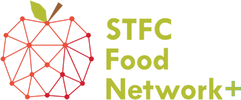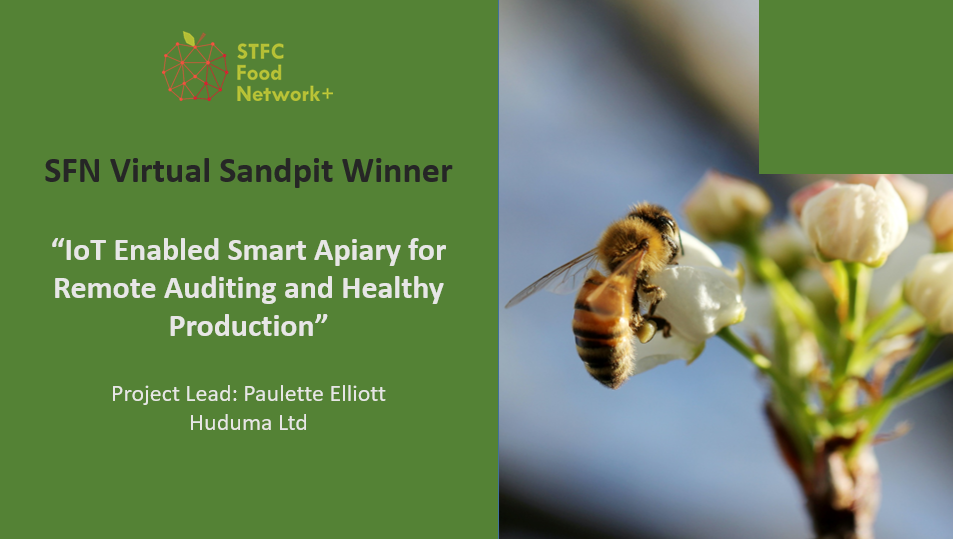|
In our last blog post, we told the story of how the STFC Food Network+ (SFN) didn’t let a global pandemic stop the most recent Sandpit from going ahead by transitioning the whole event online for the first time. Although this gave a very different experience to the usual, in-person format, this clearly didn’t impact the quality of the proposals which resulted from the discussions. Here we feature the winning projects for each theme, which were decided by democratic vote to receive £10K each in funding. Theme 1: Sustainable production at uncertain times – smart beehive monitoring Bees and other pollinators play a crucial role in agriculture: approximately 70% of our food crops depend on them. Yet pollinators are suffering from a perfect storm of challenges, including diseases, climate change, air pollution and toxic insecticides. For the SFN Sandpit’s winning theme 1 project, Paulette Elliott (Huduma) and her colleagues will be developing a prototype sensor to monitor honey bee hives in real time. “There are already various sensors on the market, for instance to monitor the hive’s humidity or to count the bees as they enter and leave the hive” Paulette says. “Our aim is to use machine learning and artificial intelligence to analyse the data from these existing sensors to see where there are repeated anomalies or trends that can identify specific problems.” This knowledge will then be applied to build a proof-of-concept sensor for a particular issue. In contrast to existing sensors that currently use Wi-Fi or mobile data technologies, the new sensor will be linked with satellite technology, extending its capabilities further. For instance, earth observation remote sensing information could help beekeepers understand if their hives are in the optimum location, either to avoid air pollution hotspots or to access the bee’s preferred source of pollen. Besides involving experts across a broad range of fields, the project is also committed to engaging with end-users. As Managing Director of Huduma, Paulette brings significant experience of working with start-ups and SMEs to develop successful business models for emerging technologies, particularly those based on Internet of Things and autonomous systems. Her colleagues and Co-Investigators include high-performance computing specialists, experts in mathematical modelling from STFC Hartree, University of Warwick, The Open University, UKRI-STFC and the company OPTIfarm, which currently provides real-time monitoring systems for poultry farms. “We intend to collaborate with beekeepers’ networks across the country, including both hobbyists and commercial” says Paulette. “Rather than assuming what the most important issues are, we want to work in partnership with them to identify the most critical factors for bee colony health.” Theme 2: Resilient food supply chains at uncertain times – Better indicators to spot food fraud Ever since food began being traded as a commodity, fraudsters have tried to make a quick profit at the customer’s expense. Fraud costs the UK food economy approximately £11 billion each year, but this may be only the tip of the iceberg since fraud is frequently underreported. Besides the financial repercussions, this can have serious health consequences, for example by exposing consumers unknowingly to allergens. The Sandpit’s Theme 2 winning project aims to combat this by equipping authorities with more powerful tools to identify cases of food fraud as they happen. “It’s currently a huge challenge to detect food fraud. Often, agencies only become aware if it causes ill health or if they are alerted by an insider” says project leader Edward Smart (University of Portsmouth). To identify potential indicators of food fraud, the project will bring together a broad range of food-related databases, including import/export databases, global temperature data and commodity prices. This will be combined with a historical database of known incidences of food fraud. Data science experts at the STFC will then use powerful computational methods to hunt for patterns and trends that could have predicted these events. “As an example, if the price of a foodstuff such as oats suddenly decreases in value, this could be a sign that the market is becoming flooded with a poor quality or fraudulent product” says Edward. The ability to link such indicators to fraudulent activities, particularly during shock events such as the coronavirus lockdown, could help policy makers develop strategies to reduce the flow of fraudulent goods, such as more targeted border checks. “The Sandpit came at an opportune time since my colleague Lisa Jack and I had just completed a project on calculating the true cost of food fraud” says Edward. “At the Sandpit we were introduced to food researchers from the University of Central Lancashire, Brunel University and Fera Science Ltd. Food fraud was a common interest for all parties and as we started talking, it became clear that data science techniques could be a powerful tool in finding more effective indicators of food fraud. Theme 3: Nutritional security & consumer behaviour at uncertain times - Intelligent Data Analytics to Understand Food Consumer Practice during Food Shocks “COVID-19 and the associated lockdowns clearly demonstrated how consumer behaviour can ‘shock’ food systems, resulting in essential items becoming scarce” says Laura Wilkinson (Swansea University). “For food systems to be resilient against future shocks- for instance, as a result of further lockdowns, Brexit or climate change – it is vital that decision makers can anticipate how consumers will react.” In their winning project, Laura and her colleagues will look for trends in consumer behaviour using the huge volume of online commentary that the pandemic has generated, which can act as a ‘window’ into why people behaved as they did. To convert this heterogenous mix of images, videos and text into meaningful information, Laura and her colleagues will use an approach that combines citizen science and intelligent data analytics. “Our first step will be to categorise the data and describe the sentiment of posts: is the person laughing about the shortage of a particular food, or are they genuinely panicked about it?” The project will explore data from various sources, including Twitter, Facebook, YouTube, Instagram and Deliveroo reviews. “Using a citizen science platform (Zooniverse), we will invite members of the public to help us categorise images and text to form a ‘training dataset’. Then we will apply deep learning techniques to this dataset to teach a computer to perform the process automatically” says Laura. The end result will be a preliminary model that will be able to forecast specific events (such as flour running out of stock) on the basis of the text and images that individuals post online (e.g. comments about flour). Similar to the other winning proposals, the project brings together a diverse range of disciplines, involving psychologists, nutritionists, economists, computer scientists and data analysts. “We also benefit from being able to access STFC’s high-performance computing facilities and experience in running citizen science projects” Laura says. If successful, she hopes that the group will be able to access additional funding to both scale-up the model and engage retailers, so that they can additional information, such as sales data, to better understand the relationship between consumer sentiment and their buying behaviours. Look out for our future blog posts which will give updates on the progress of the projects funded in our previous Sandpit events and funding calls
0 Comments
Your comment will be posted after it is approved.
Leave a Reply. |
AuthorJune 2024 - Archives
June 2024
Categories |
- Home
- Webinars and Events
- About the SFN+
- News
- Blog
- Expert Working Groups
- Funding
-
Publications
- Bioeconomy positioning paper
- SFN+ 5th Annual Conference
- OMM Policy Report
- ‘Multi-Stakeholder International One Day Workshop on Organic Agri-Food Value Chains for Net Zero’ Report
- SFN 2050 UK Net Zero Food report
- Sustainable Cold Food Chain Booklet
- Food Sensing Technologies for Safe and Nutritious Food
- Sustainable urban and vertical farming
- Projects
- Join/Contact Us




 RSS Feed
RSS Feed


